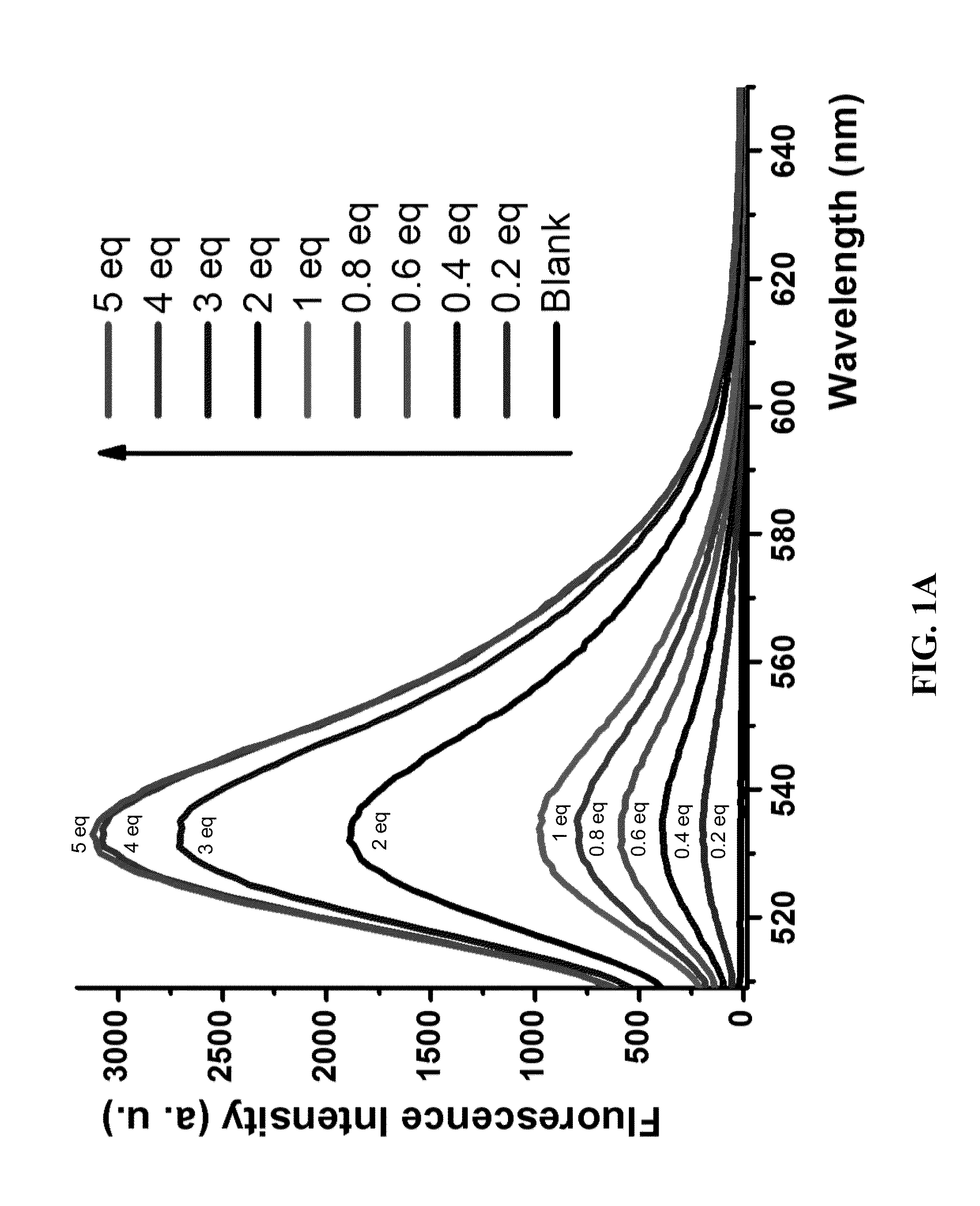Diarylamine-based fluorogenic probes for detection of peroxynitrite
a fluorogenic probe and diarylamine technology, applied in the direction of instruments, group 3/13 element organic compounds, chemical indicators, etc., can solve the problems of limited intracellular retention of existing green fluorescent probes in cell assays, serious damage to various biological molecules, protein, lipids and dna, etc., to increase or decrease the level of peroxynitrite
- Summary
- Abstract
- Description
- Claims
- Application Information
AI Technical Summary
Benefits of technology
Problems solved by technology
Method used
Image
Examples
example 1
Synthesis of Green Fluorogenic Compounds 1, 2, and 10
[0193]
[0194]To a solution of the starting phenol (4.3 g, 10.6 mmol) in DMF (30 mL) were added Et3N (7.5 mL, 53.1 mmol) and N-phenyl-bis(trifluoromethanesulfonimide) (4 g, 11.7 mmol) under Ar at room temperature. The mixture was stirred overnight and then diluted with ethyl acetate (300 mL). The organic solution was washed with HCl solution, water, and dried over anhydrous sodium sulfate, and then concentrated in vacuo. The residue was purified by silica gel column chromatography to give 34 (5.4 g, 95% yield). 1H NMR (400 MHz, CDCl3) δ 8.94 (d, J=1.5 Hz, 1H), 8.45 (dd, J=7.9, 1.5 Hz, 1H), 8.41-8.34 (m, 2H), 8.03 (d, J=0.7 Hz, 1H), 7.50 (d, J=7.9 Hz, 1H), 7.44 (d, J=1.8 Hz, 1H), 7.43 (d, J=1.8 Hz, 1H), 7.10 (dd, J=8.8, 1.8 Hz, 1H), 7.08 (dd, J=8.8, 1.8 Hz, 1H), 7.03 (d, J=8.8 Hz, 1H), 7.00 (d, J=8.8 Hz, 1H), 6.85 (d, J=9.8 Hz, 1H), 6.82 (d, J=9.8 Hz, 1H), 6.54 (dd, J=9.8, 1.8 Hz, 1H), 6.52 (dd, J=9.8, 1.8 Hz, 1H), 6.42 (d, J=1.8 Hz,...
example 2
Synthesis of Yellow Fluorogenic Compound 11
[0206]
[0207]The suspension of the starting materials in TFA was heated to 100° C. for 4 hr in a sealed-tube. The resulting red solution was then concentrated in vacuum and azeotroped with toluene three times to provide the crude product of 44, which was purified by silica gel column chromatography to give the pure product. 1H NMR (400 MHz, CDCl3) δ 8.15 (d, J=6.9 Hz, 1H), 7.68-7.61 (m, 2H), 7.22-7.18 (m, 1H), 6.86 (s, 1H), 6.79 (s, 0.5×1H), 6.77 (s, 0.5×1H), 6.56 (s, 1H), 6.48 (s, 1H), 4.22 (br, 1H), 4.20 (q, J=7.0 Hz, 2H), 3.55-3.43 (m, 1H), 3.30-3.17 (m, 1H), 2.80-2.60 (m, 1H), 2.45 (t, J=6.5 Hz, 2H), 2.05-1.88 (m, 2H), 1.69 (d, J=12.9 Hz, 1H), 1.49 (dt, J=20.1, 12.9 Hz, 1H), 1.35 (s, 3H), 1.31 (t, J=7.0 Hz, 3H), 1.21 (s, 3H), 1.07 (d, J=6.3 Hz, 0.5×3H), 0.99 (d, J=6.3 Hz, 0.5×3H).
[0208]To a solution of 44 in DMF were added Et3N and N-phenyl-bis(trifluoromethanesulfonimide) under argon at room temperature. The mixture was stirred overnigh...
example 3
Synthesis of Red Fluorogenic Compound 22
[0211]
[0212]To a solution of 47 in DMF were added Et3N and N-phenyl-bis(trifluoromethanesulfonimide) under Ar at room temperature. The mixture was stirred overnight and then diluted with ethyl acetate. The organic solution was washed with HCl solution, water, and dried over anhydrous sodium sulfate, and then concentrated in vacuo. The residue was purified by silica gel column chromatography to give the product 48 (92% yield). 1H NMR (400 MHz, CDCl3) δ 7.96 (s, 1H), 7.92 (d, J=7.9 Hz, 1H), 7.50 (d, J=2.8 Hz, 1H), 7.17 (d, J=7.9 Hz, 1H), 7.08 (dd, J=9.0, 2.8 Hz, 1H), 6.90-6.87 (m, 2H), 6.84 (d, J=2.1 Hz, 1H), 6.21 (dd, J=10.2, 2.1 Hz, 1H), 2.09 (s, 3H), 1.59 (s, 9H), 0.52 (s, 3H), 0.50 (s, 3H); 13C NMR (101 MHz, CDCl3) δ 184.13, 165.18, 151.50, 149.68, 145.80, 142.75, 141.29, 140.70, 140.30, 138.15, 136.47, 134.31, 132.49, 131.45, 130.89, 129.45, 129.33, 129.03, 127.25, 126.59, 123.02, 122.76, 118.67 (q, JC-F=322.1 Hz), 81.45, 28.14, 19.50, −1.4...
PUM
 Login to View More
Login to View More Abstract
Description
Claims
Application Information
 Login to View More
Login to View More - R&D
- Intellectual Property
- Life Sciences
- Materials
- Tech Scout
- Unparalleled Data Quality
- Higher Quality Content
- 60% Fewer Hallucinations
Browse by: Latest US Patents, China's latest patents, Technical Efficacy Thesaurus, Application Domain, Technology Topic, Popular Technical Reports.
© 2025 PatSnap. All rights reserved.Legal|Privacy policy|Modern Slavery Act Transparency Statement|Sitemap|About US| Contact US: help@patsnap.com



